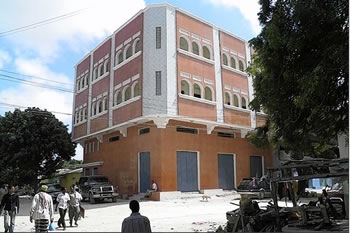As Thousands Flee Mogadishu, Mr. Nur Builds Homes on Safer Outskirts; Pitching a German-Style Villa
For Abdullahi Nur, it has opened up a new line of business.
Mr. Nur is among a band of property developers in Somalia who are catering to displaced people—getting into the real-estate business when most are getting out. "I can get a German-style villa or a two-story house for you," Mr. Nur said into his cellphone on a recent day, fielding call after call from potential buyers as he gave a tour of some of his properties. "Whatever you prefer."
Some 51,000 people have fled their homes in Somalia's capital, Mogadishu, since late August as Islamist militants battle in the streets against African Union and government troops. A militant attack on government soldiers Sunday left at least 15 people dead and 20 wounded, the latest in a drumbeat of attacks and counterattacks that have taken a toll on civilians caught in the cross-fire.
In all, fighting has displaced 1.5 million of Somalia's nine million people, the United Nations says.
The result is a surge in demand for property in safer areas of the capital or in areas beyond, say Somali property developers. Because property-sector tracking is nonexistent, evidence of a thriving real-estate market in these safer areas is anecdotal.
Developers here say Somalis have begun selling their homes as they flee fighting in Mogadishu. Wealthier Somalis have moved out of makeshift tent cities outside the capital and into built-to-order homes nearby.
Mr. Nur, a 41-year-old former restaurateur, got into the real-estate business when bombings kept people away from his Mogadishu eateries. Somalis' flight has allowed him to reap a "large profit," he says.
Like other agents, Mr. Nur says he began buying Mogadishu homes on the cheap from residents who didn't expect to return. While the capital is filled with shelled ruins, the best of its housing stock includes colonnaded multistory buildings and historic villas. Mr. Nur hopes to eventually restore the buildings and sell them at a markup when people begin trickling back.
He also offers built-to-order homes near displacement camps about 12 miles south of Mogadishu. The area, known as Elasha Biyaha, is part of the Afgoye a corridor outside of Mogadishu where some 400,000 people have fled, according to the United Nations. The region has become increasingly urbanized, according to the U.N., and real-estate values have spiked.
Once covered in dense forests, Elasha Biyaha is far enough from the capital to avoids the regular shelling between al Shabaab, a militant group believed to have al Qaeda ties, and African Union-backed government troops. Today, it is populated with displaced Somalis, most of whom have cleared brush and set up makeshift homes with sticks, plastic sheeting and old clothing. Families with more money build shacks from metal sheeting.
 Bile Dahir for The Wall Street Journal A home recently completed by Abdullahi Nur just outside the capital. |
On the recent tour, Mr. Nur, clad in coffee-colored jeans and a blazer, showed off four of the 10 houses he says he has built, including a three-story, orange-tiled home with neat rows of arches, and an imposing cement frame of a home that will feature rounded balconies on three levels that rise above the street.
Like many Somali businessmen, Mr. Nur imports his materials from Dubai and contracts building to independent construction workers. He offers two upscale models—from $90,000 and $45,000—and another, made of stone, for $6,000. Within a month, buyers can move into their new homes, according to Mr. Nur and those who have bought from him.
Larger homes tend to go to wealthy Somali businessmen. The smaller homes have become a respite for Mogadishu families.
Among the reluctant settlers is Halwo Mohamed, the 49-year-old mother of eight who says she was determined to stand her ground in her Mogadishu villa.
That changed earlier this year, she says, when militants beheaded three local teens, accusing them of spying for the Somali government, and left their bodies in the street. She says the militants later took up position behind her house to fire mortars at government forces. An African Union shell zipped back and crashed into her home, she says, killing one of her children.
The African Union mission in Somalia said that it "does not shell indiscriminately at civilian populated areas," and said it isn't responsible for civilian casualties in Somalia.
Six months ago, Mrs. Mohamed called Mr. Nur and sold her villa to him for $30,000, a small price for what she calls a princely home with a walled yard. "I have no hope of returning," she said.
For $6,000, she bought a small stone home in Elasha Biyaha.
Mr. Nur shrugs off criticisms that he is exploiting homeowners by buying their houses on the cheap. "This business is good for the people," he said. "They can sell their homes in times of desperation and move to the sunny bushland."
—Sarah Childress in Nairobi contributed to this article.